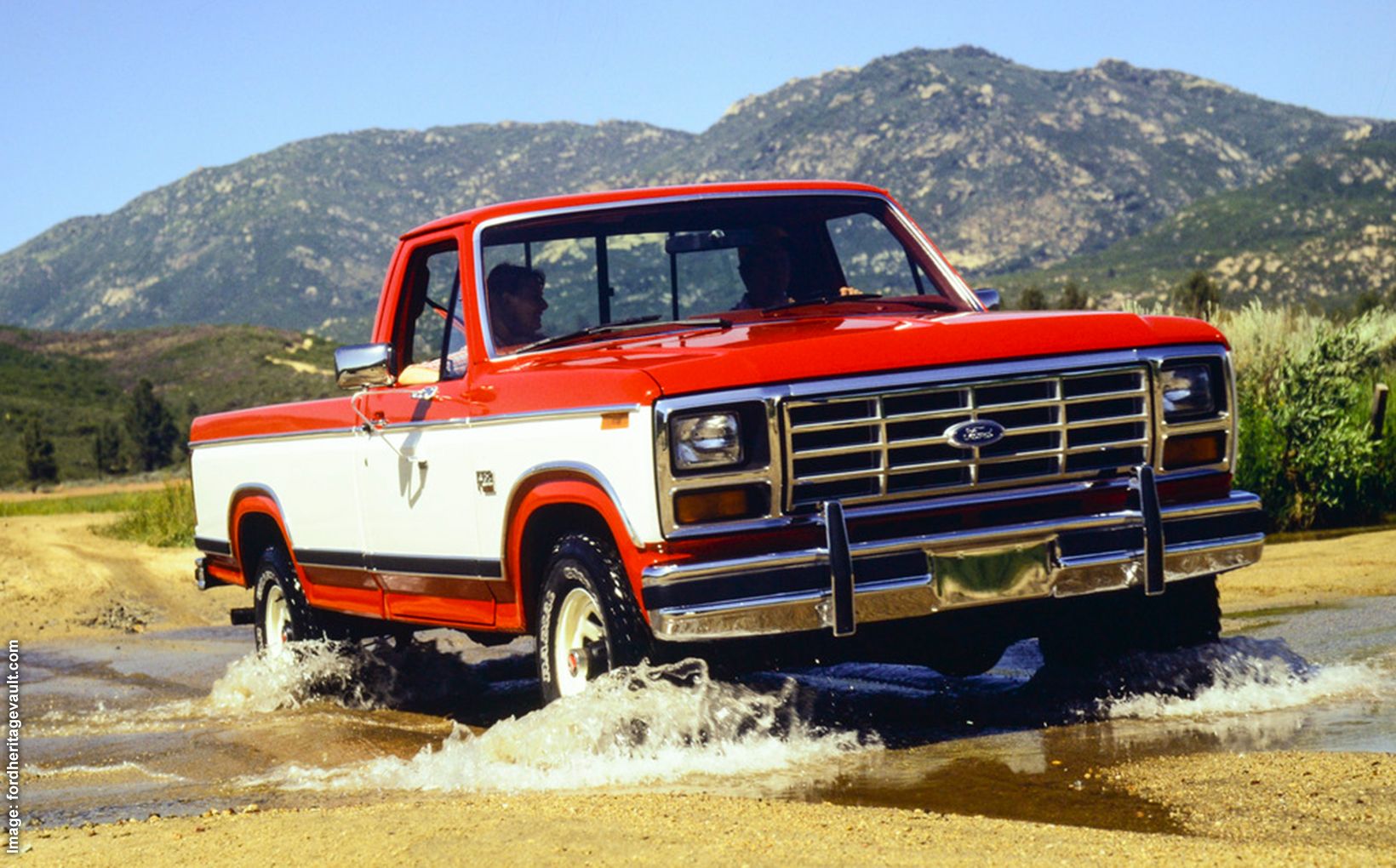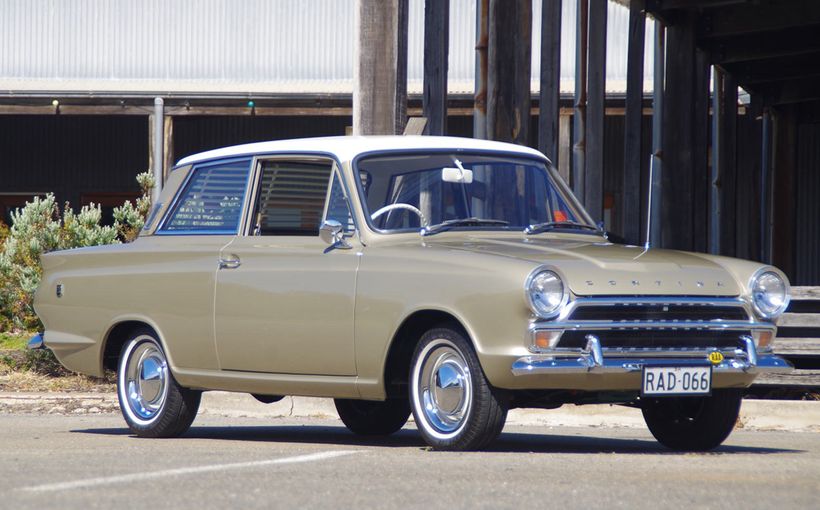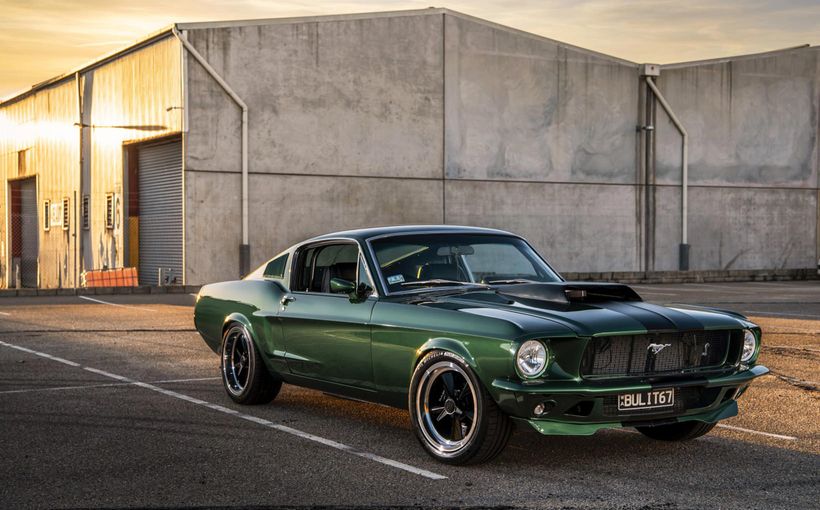Ford F-Series: the world’s favourite pickup truck

It’s been the USA’s best-selling pickup for 47 years. It’s also been the top-selling vehicle there for 42 years. Since its creation in 1948, Ford has produced more than 43 million F-Series pickups, making it second only to the Toyota Corolla as the world’s best-selling model ever.
During its staggering 76 years in production, this American icon has spawned a vast number of variants and been sold in numerous overseas markets including Australia, where it’s now remanufactured in RHD form at a dedicated Ford-backed facility in Melbourne.
To cover all models would require several volumes, so this review focuses on the quintessential half-tonne to one-tonne pickups that have underpinned the F-Series’ enduring popularity through 14 generations.

Image: https://fordheritagevault.com/
1st Gen (1948-1952)
The advent of the F-Series heralded a new era for commercial vehicles, as Ford shook off the shackles of WW2 military production to create a new peace-time truck range tailored to farmers and tradesmen rather than GIs.
The fresh lines of Ford’s ‘Bonus Built’ pickup featured smooth extended front fenders and matching ‘Flareside’ rears, a neat horizontal-bar grille and one-piece windshield. Both pickup and panel van body styles were offered, but the van option was short-lived.
Model designations were F-1 (half-tonne payload rating), F-2 (three-quarter-tonne), F-3 (one-tonne) etc up to the F-7 (2.5-tonne) and F-8 (3.0-tonne) heavy-duty cab-chassis variants.
There was a standard three-speed gearbox and pickup models had a choice of antiquated side-valve 226cid inline six or 239cid side-valve V8. However, by 1952 more modern overhead-valve engines became available.

Image: https://fordheritagevault.com/
2nd Gen (1953-1956)
Ford celebrated its Golden Anniversary in 1953 with fresh F-Series styling, featuring a longer and wider bonnet, broader grille and airy cabs with more glass area.
The model names were also expanded to three numbers, which have remained ever since. The half-tonne F-1 became the F-100, the F-2 and F-3 were combined into the three-quarter-tonne F-250 and the F-4 became the one-tonne F-350.
Automatic transmission became available, and engines were modernised with new OHV ‘Y-Block’ V8s and OHV inline sixes replacing the old side-valves. Optional power brakes, wraparound windscreens and restyled dashboards were added during this model run.

Image: https://fordheritagevault.com/
3rd Gen (1957-1960)
Another bold change in styling with a wider and more squared-off look. Fully integrated front fenders capped by a flat full-width bonnet established a design template for all future models.
The increased width resulted in more spacious cabs and buyers could now choose between traditional Flareside or new ‘Styleside’ load-bed option.

Image: https://fordheritagevault.com/
The Styleside increased load volume by extending the cab’s full-width styling all the way to the tailgate, with integrated rear wheel-housings like the fronts. Available in different lengths and wheelbases, the Styleside has become an industry standard for contemporary pickup design.
More powerful sixes and V8s improved performance and by 1958 nearly all Ford trucks had been restyled with quad-headlights. In 1959 the company also commenced in-house production of 4x4 F-100 and F-250 pickups.

Image: https://fordheritagevault.com/
4th Gen (1961-1966)
The new decade brought fresh styling, redesigned interiors, more car-like options and drivetrain choices.
The longer and lower F-Series offered even more style for 4x2 Styleside buyers, with an optional unitary body featuring integrated cab and load-bed like the car-based Ranchero ute. However, it proved unpopular and was discontinued after only two years.
Like its predecessors, various grille designs appeared during this model run, plus there were new double-walled Styleside load-beds to protect the outer skin from being dented by internal loads. This has also become an industry standard.
1965 brought a significant mid-cycle redesign including a new dashboard layout and the ‘Ranger’ name (previously an Edsel base-model) was dusted off and reassigned as the premium trim level for F-Series pickups. A new four-door crew-cab body was offered for F-250/F-350 buyers.
There was also a revised chassis-frame incorporating Ford’s new ‘Twin I-Beam’ independent front suspension for 4x2 variants, with softer ride and improved handling. Powerful new engines included 240cid and 300cid inline sixes plus a 352cid V8.

Image: https://fordheritagevault.com/
5th Gen (1967-1972)
Fresh styling brought a larger grille and cleaner front-end appearance, along with prominent full-length side spears and more spacious interiors with a car-like instrument panel.
Powertrain options expanded to include larger V8s up to 390cid. 1970 brought a switch from the traditional metal-bar grille to a tough but light plastic version in a distinctive ‘egg-crate’ pattern.
Customers were demanding plusher trim levels and upmarket options, including fully integrated factory air. In response, the new premium Ranger XLT trim raised the luxury bar another notch with carpet, woodgrain inserts, full-length body mouldings, cloth seat trim etc. Buyers could even order a vinyl roof option.

Image: https://fordheritagevault.com/
6th Gen (1973-1979)
Customary updated styling and larger cabs, plus front disc brakes and increased use of galvanised steel in construction. A monster 460cid (7.5-litre) V8 topped the engine line-up.
In 1974 came the first extended-cab, or ‘SuperCab’ in Ford speak. This versatile option (invented by Dodge) allowed more luggage space than a single-cab and enough room for rear passengers on fold-down seating.
A year later came the new F-150, designed to split the difference in payload capacity between the half-tonne F-100 and three-quarter-tonne F-250.
In 1977 the F-Series celebrated a significant milestone in becoming the USA’s top-selling vehicle - and has held that coveted position ever since!
The following year came an all-new version of the Bronco SUV, which for the first time since its 1966 launch was derived from the F-Series pickup. The new Bronco and updated F-Series shared the latest ‘Louisville’ facelift and Lariat became the new top-shelf F-Series trim level.

Image: https://fordheritagevault.com/
7th Gen (1980-1986)
In the wake of the world’s second energy crisis, the latest generation featured straighter lines and more streamlined aero to optimise fuel economy.
The F-100 was also available with a little 255cid V8 - even smaller than the standard 300cid six. By contrast, V8 engine options up to 460cid were still available and 4x4 models finally got independent front suspension thanks to a new ‘Twin Traction Beam’ design.
In 1983 the F-250 and F-350 could be optioned with a 420cid (6.9-litre) diesel V8 sourced from a joint venture with International Harvester and all F-Series petrol engines were fuel-injected by the end of the decade.
In 1984 the iconic F-100 was axed after three decades, because its light duty GVW (Gross Vehicle Weight) rating meant it could not comply with new federal emission laws that did not apply to heavier trucks. A dual-rear-wheel version of the F-350 pickup also became available.

Image: https://fordheritagevault.com/
8th Gen (1987-1991)
First major styling revision since 1980 brought a smoother and more aero-efficient front fascia, with the nostalgic Flareside load-bed option dropped again but destined to return. There was also a new interior design plus rear-wheel anti-lock brakes and standard five-speed manual.
Ford also introduced a new line of F-350s with higher GVWs, designed to fill the gap between regular F-350 and heavier duty F-600 cab-chassis. The 460 petrol V8 was standard with the optional IH-sourced diesel V8 growing from 6.9 to 7.3-litres.
The four-speed automatic option was available with all engines and 4x4 models got standard automatic-locking front hubs. An optional and popular ‘Nite’ trim package for F-150s included blackout exterior trim and alloy wheels.

Image: https://fordheritagevault.com/
9th Gen (1992-1997)
A second major revision of the new-for-1980 styling theme with an enduring emphasis on aero-efficiency, highlighted by a slightly lower bonnet line and smoother front fascia. By contrast, the venerable Flareside load-bed option returned on single and extended-cab models.
In 1993 came the new SVT (Special Vehicle Team) Lightning, based on an F-150 equipped with a potent 351cid V8, sports suspension, alloy wheels and special paint for those wanting the utility of a truck with muscle car performance. An uprated SVT Lightning was released in 1995.

Image: https://fordheritagevault.com/
10th Gen (1997-2004)
The latest F-Series heralded the most extensive redesign in almost two decades, which created a clear distinction between light duty and heavy duty pickups.
The light duty F-150’s distinctive and polarising new styling was consistent with Ford’s latest ‘New Edge’ global design language, with a softer and more contoured car-like appearance.
This styling change, along with the addition of rear doors to extended-cabs to improve passenger access, a new crew-cab option with four full-size doors and a new IFS on 4x2 models, acknowledged the growing dual-purpose appeal of the F-150 as a second family car. There were also new V6 and ‘modular’ SOHC V8s.

Image: https://fordheritagevault.com/
F-Series buyers wanting the latest work-focused models had to wait until 1999 when Ford introduced the restyled F-250HD (Heavy Duty) and F-350 as the first generation of a new 'Super Duty' pickup range, with imposing grilles and brawnier looks befitting their big load-hauling abilities. Buyers could choose either a 7.3-litre turbo-diesel V8 or new 6.8-litre petrol V10, both with massive outputs.
1999 also saw the SVT Lightning return with a vengeance, now propelled by an exclusive supercharged version of the modular 5.4L V8. The gigantic Excursion SUV, derived from the F-250HD, arrived in 2000 but was dropped five years later due to soaring petrol prices and poor sales.

Image: https://fordheritagevault.com/
11th Gen (2004-2008)
Another F-150 redesign and all-new chassis platform, featuring a stronger fully-boxed frame and relocated rear shocks for improved ride and handling.
All F-150s now had four doors, regardless of cab type, with Ford even adding slender rear doors to the single-cab to improve access to behind-seat storage. Latest three-valve 5.4L V8 became available, along with more F-150 variants including the new off-road-focused FX4 trim level.
The Super Duty models were also given a new chassis platform along with a facelift featuring much larger grille and headlights, plus a fresh interior design. Also, the mighty F-450, previously available only in cab-chassis form, was now available as a pickup.

Image: https://fordheritagevault.com/
12th Gen (2009-2014)
The latest F-150 was defined by its bold Super Duty-style grille and large sweptback headlights. The slender single-cab rear doors were discontinued, along with the venerable Flareside load-bed with its F-1 retro-inspired origins. Manual transmission was discontinued, replaced by a six-speed auto.
New F-150 powertrain choices comprised a standard 3.7-litre V6, optional twin-turbocharged 3.5-litre EcoBoost V6 and the return of 5.0-litre eight-cylinder power in the form of Ford’s new ‘Coyote’ DOHC 32-valve aluminium V8.

Image: https://fordheritagevault.com/
In the wake of the road-focused F-150 Lightning came another specialised version from SVT, but with an off-road focus this time: the Raptor.
Released in 2010, this Baja 1000-inspired predator based on the F-150 SuperCab (plus crew-cab in 2011) had a beefed-up chassis, long-travel Fox Racing suspension, big tyres and unique F-O-R-D front fascia, powered by a potent 6.2-litre ‘Boss’ V8. Instant classic!

Image: https://fordheritagevault.com/
13th Gen (2015-2020)
Only minor cosmetic tweaks but a big advance was extensive use of high-strength military-grade aluminium in body construction. These new rust-free panels (only the firewall was steel) brought substantial reductions in kerb weight, resulting in lower fuel consumption and higher payloads.
The latest F-Series was also claimed to be the first pickup equipped with adaptive cruise control and engine changes saw a new 3.5-litre V6 as the base engine, the 5.0-litre V8 continue as an option and the Boss 6.2-litre V8 was dropped.
The ubiquitous six-speed auto continued for all engines except the latest version of the EcoBoost V6, which was paired with an equally new 10-speed automatic. A second version of the Raptor benefitted greatly from the much lighter aluminium body and its V8 was replaced by the EcoBoost V6.

Image: https://fordheritagevault.com/
14th Gen (2021-present)
Although similar in appearance to its predecessor, there was substantial F-150 styling refinement with revision of all external panels to optimise aerodynamic performance and engine efficiency.
A new ‘PowerBoost’ hybrid drivetrain option was introduced, which paired the 3.5-litre Bi-Turbo EcoBoost V6 with an electric motor for unparalleled response and economy.
Buyers could still choose between V6 and V8 power, but the six-speed auto was dropped in favour of the slick-shifting 10-speed auto across the board.
A third-gen F-150 Raptor was launched in 2021, with rear coils replacing the previous leaf-springs along with a high-output version of the EcoBoost V6. Only the crew-cab body style was offered and a V8 engine returned as an option.
In 2022 Ford also launched the first F-Series variant not powered by a combustion engine. The F-150 Lightning was instead equipped with a full battery-electric drivetrain, but slow sales prompted sharp reductions in production one year later.
Automotive Icon
The vast popularity of the F-Series, particularly in North America, is showing no sign of waning as Ford continues its evolution with new styling, drivetrains, models and capabilities. With more than 43 million produced in almost eight decades, the iconic F-Series pickup is a quintessential Super Model.








